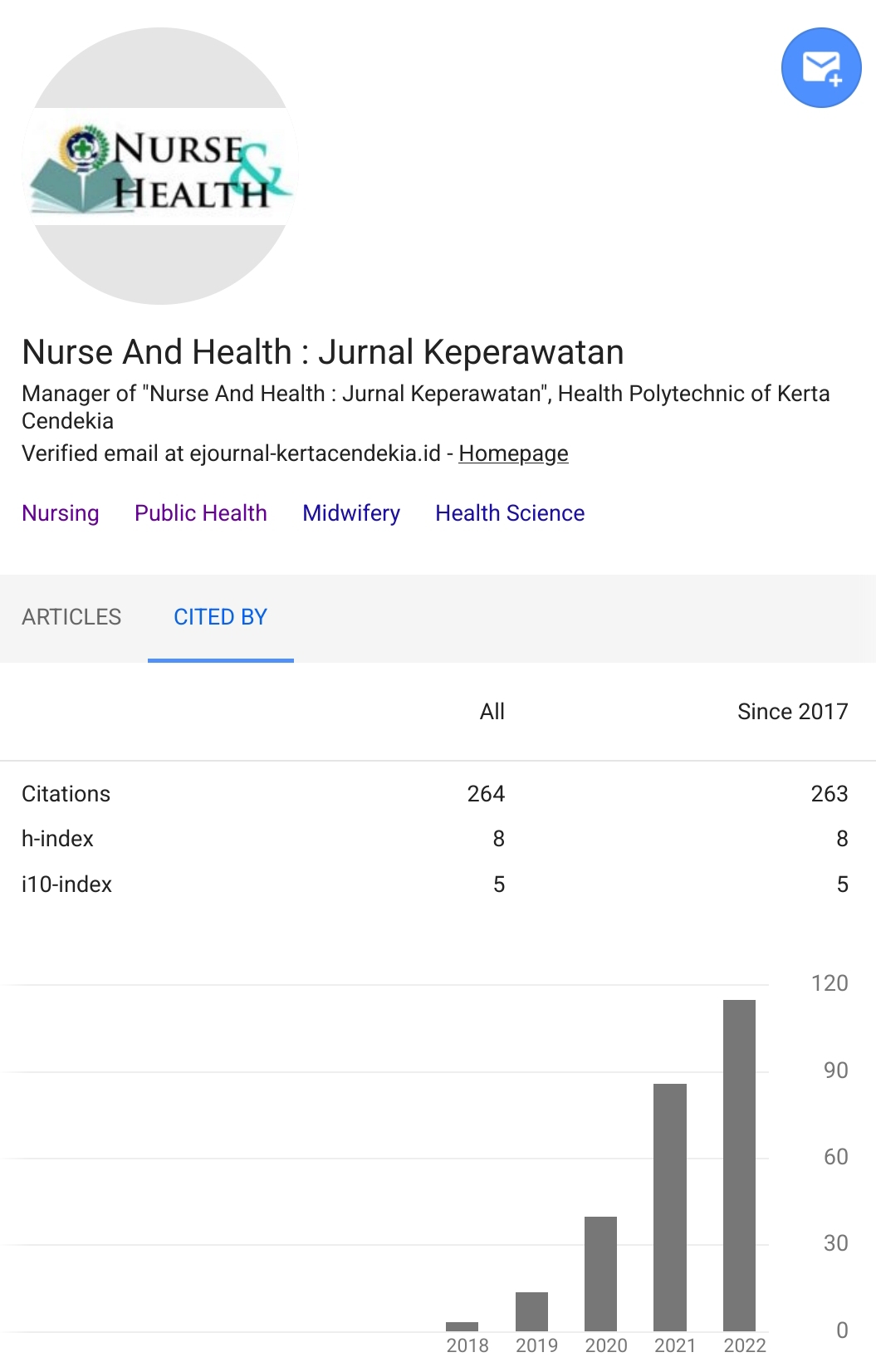COUNTERPRESSURE FOR DYSMENORRHEA PAIN IN TEENAGERS
Abstract
Background: Teenager is a one of development stages in the life cycle. Female teenagers are often marked by the menstrual phase. Menstruation is often accompanied by pain or what is called dysmenorrhea. Dysmenorrhea is often experienced by female teenagers and it can interfere with the activity and ability of concentration in learning that results in a decrease in performance in school. Counterpressure can be used as a solution to overcome the problem of dysmenorrhea. The counterpressure massage technique is applying strong pressure using the heel of the hand by clenching the lumbar region where there is a uterine sensory nerve that runs with the sympathetic uterus entering the spinal cord through the thoracic nerve 10-11-12 which can increase the endorphin hormone. The purpose of this study was to analyze the effect of counterpressure massage on dysmenorrhea pain in high school students.Objective: The purpose of this study was to analyze the effect of counterpressure massage on dysmenorrhea pain in high school students.Method: The research design used was quasi experiment (one group pre-posttest design). The location of this research was Kartika IV Senior Hight School in Surabaya. The number of respondents was 30 respondents taken by consecutive sampling technique. The instrument was using NRS observation method by Hjermstad (2011). Analysis of the data in this study was using the Wilcoxon Test with a significance level 0.05 with a significance level of 0.05.Result: Wilcoxon test results obtained p value of 0.00 (p <0.05). These results indicate that there are significant differences for dysmenorrhea pain before and after the counterpressure intervention has given.Conclusion: Counterpressure massage techniques can reduce dysmenorrhea pain experienced by female teenagers. Key words: Counterpressure massage, Dysmenorrhea, Female Teenagers.Downloads
References
Altangarvdi, B., Chi, H. U. A. N. G., Mengxiang, L. I. U., Jing, L. U., Huiting, P. E. N. G., Sapkota, C., & SHENG, J. (2019). Status and factors of menstrual knowledge, attitudes, behaviors and their correlation with psychological stress in adolescent girls. Journal of pediatric and adolescent gynecology.
Anurogo, D., & Wulandari, A. (2011). Cara jitu mengatasi nyeri haid. Yogyakarta: Andi.
Arif, Mansjoer. (2003). Kapita Selekta Kedokteran. Jakarta: Media Aesculapius.
Badan Pusat Statistik Jakarta Pusat. (2010). Statistik Indonesia Tahun 2010. Jakarta Pusat: Badan Pusat Statistik.
Baziad, A., Jacoeb, T.Z., Surjana, H. E. J., Alkaff, H. Z. (2004). Endokrinologi-Ginekologi Edisi Kedua. Jakarta: Kelompok Studi Endokrinologi Reproduksi Indonesia (KSERI) Bekerjasama dengan Media Aesculapius.
Berger, B., Böning, A., Martin, H., Fazeli, A., Martin, D. D., & Vagedes, J. (2019). Personal perception and body awareness of dysmenorrhea and the effects of rhythmical massage therapy and heart rate variability biofeedback—A qualitative study in the context of a randomized controlled trail. Complementary Therapies in Medicine.
Bobak, IM, L.D., Jensen MD, Perry SE. (2012). Buku Ajar Keperawatan Maternitas. Jakarta: EGC.
Chen, C. X., Draucker, C. B., & Carpenter, J. S. (2018). What women say about their dysmenorrhea: a qualitative thematic analysis. BMC women's health, 18(1), 47.
Danuatmaja, B.DM. (2014). Persalinan Normal Tanpa Rasa Sakit: Puspa Swara.
Ernawati. (2010). Terapi Relaksasi terhadap Nyeri Dismenore pada Mahasiswi Universitas Muhammadiyah Semarang.
Hjermstad, M. J., Fayers, P. M., Haugen, D. F., Caraceni, A., Hanks, G. W., Loge, J. H., ... & European Palliative Care Research Collaborative (EPCRC. (2011). Studies comparing Numerical Rating Scales, Verbal Rating Scales, and Visual Analogue Scales for assessment of pain intensity in adults: a systematic literature review. Journal of pain and symptom management, 41(6), 1073-1093.
Lee, M. S., Lee, H. W., Khalil, M., Lim, H. S., & Lim, H. J. (2018). Aromatherapy for managing pain in primary dysmenorrhea: A systematic review of randomized placebo-controlled trials. Journal of clinical medicine, 7(11), 434.
Maryunani, A. (2010). Nyeri Dalam Persalinan. Jakarta: CV. Trans Info Media.
Mou, L., Lei, W., Chen, J., Zhang, R., Liu, K., & Liang, X. (2019). Mediating effect of interpersonal relations on negative emotions and dysmenorrhea in female adolescents. General psychiatry, 32(1).
Pratiwi, D., & Nurullita, U. (2017). PERBEDAAN EFEKTIFITAS TEHNIK COUNTER-PRESSUREDAN KOMPRES HANGAT TERHADAP PENURUNANNYERI PERSALINAN KALA I FASE AKTIFDI RSUD SUNAN KALIJAGA DEMAK. Karya Ilmiah.
Santiasari, R. N., Nurdiati, D. S., Lismidiati, W., & Saudah, N. (2018). Effectiveness of Effleurage and Counter-Pressure Massages in Reducing Labor Pain. Health Notions, 2(7), 721-724.
Syaidah, E., & Utomo, T. Y. A. K. E. (2011). Analisis Posisi Ibu Bersalin Miring Ke Arah Ubun-Ubun Kecil Terhadap Lama Fase Aktif Kala I di Puskesmas Sukodono Sragen. Jurnal Kebidanan, 3(2).
Tangchai, K., Titapant, V., & Boriboonhirunsarn, D. (2004). Dysmenorrhea in Thai adolescents: prevalence, impact and knowledge of treatment. Journal-medical association of thailand, 87, S69-S73.
Vagedes, J., Fazeli, A., Boening, A., Helmert, E., Berger, B., & Martin, D. (2019). Efficacy of rhythmical massage in comparison to heart rate variability biofeedback in patients with dysmenorrhea—A randomized, controlled trial. Complementary therapies in medicine, 42, 438-444.
Ward L. S. and Shekton M. H. (2009). Maternal Child Nursing Care. Philadelphia: F. A. Davis Company.
Authors who publish with Nurse and Health: Jurnal Keperawatan agree to the following terms:
- Authors retain copyright licensed under a Creative Commons Attribution-NonCommercial 4.0 (CC BY-NC 4.0), which allows others to remix, tweak, and build upon the authors' work non-commercially, and although the others' new works must also acknowledge the authors and be non-commercial, they don't have to license their derivative works on the same terms.
- Authors are permitted and encouraged to post their work online (e.g., in institutional repositories or on their website) prior to and during the submission process, as it can lead to productive exchanges, as well as earlier and greater citation of published work (See The Effect of Open Access). Authors can archive pre-print and post-print or publisher's version/PDF.








_resize1.jpg)















